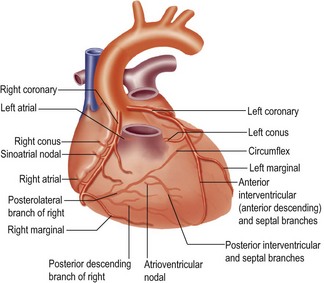14 Cardiothoracic surgery
Ischaemic heart disease
Epidemiology and aetiology
Ischaemic heart disease (IHD) includes all the consequences of narrowing or occlusion of the coronary arteries by atherosclerosis. These include angina, myocardial infarction and heart failure, arrhythmias and mitral valve incompetence. Myocardial infarction is the commonest cause of death in the UK. The risk factors and pathogenesis of atherosclerosis are the same as for peripheral vascular disease, discussed on page 203. The heart is supplied by the right and left coronary arteries. The left coronary artery is the bigger vessel and has a main stem 1 cm in length which divides into the left anterior descending artery and the circumflex artery (Fig. 14.1).
Clinical features
The manifestations of coronary artery disease vary depending on which vessels are affected and are summarised in Box 14.1.
Treatment
Risk factor modification and medical therapy
The modification of vascular risk factors is discussed in Chapter 13 on page 204. Medical therapy is aimed at reducing myocardial oxygen demand, but more severe disease requires coronary artery intervention by either angioplasty/stenting or coronary artery bypass grafting (CABG).
Coronary artery bypass grafting (CABG)
Coronary artery bypass graft is one of the most commonly performed major operations. Most are performed using cardiopulmonary bypass with hypothermia (Fig. 14.2).
Other procedures that may be carried out at the time of CABG include:
• left ventricular aneurysm excision (mortality 5%)
• mitral valve repair/replacement (mortality 15%)
• stroke (risk raised if carotid arteries stenosed)
• limb ischaemia/compartment syndrome (especially if intra-aortic balloon pump used perioperatively)
• wound problems from saphenous vein harvest
Stenting versus CABG for ischaemic heart disease
Indications for coronary bypass surgery are summarised in Box 14.2.
Box 14.2 Indications for coronary artery bypass surgery
Large clinical trials have shown that PTCA and stenting are effective in treating angina, with lower morbidity than surgery. However, the re-intervention rate is higher. CABG achieves better long-term survival, and is more effective in patients with triple vessel disease (Fig. 14.3).
Valvular heart disease
Infective/subacute infective endocarditis
This is a common condition which mainly affects aortic and mitral valves, and tricuspid in intravenous drug users. There is often an underlying valve abnormality (Table 14.1). The common organisms responsible are indicated in Table 14.2.
Table 14.1 Abnormalities associated with infective endocarditis
| Site | Abnormality |
|---|---|
| Aortic valve | Congenital bicuspid valveDegenerative valve diseaseRheumatic disease |
| Mitral valve | Rheumatic disease |
| Prolapsing valve | |
| Any prosthetic valve | Adherent thrombus |
| Congenital cardiac abnormalities | Patent ductus arteriosusSeptal defect |
Table 14.2 Organisms involved in infective endocarditis
| Bacterium | Antecedents | Pathological features |
|---|---|---|
| Streptococcus viridans | Dental extraction Other instrumentation: GI endoscopy, cystoscopy, bronchoscopy |
Often congenital abnormality of valve |
| Enterococcus | Prostatic disease Pelvic surgery |
Older patients |










